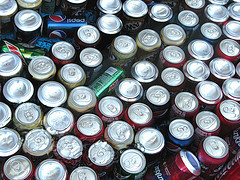Here’s Why It Never Hurts To Give Your Soda Can A Rinse
The folks at CBS 11 in Fort Worth decided to have a lab take swabs of the tops of cans purchased at various stores and machines in the area. And to anyone who has studied basic microbiology, it’s probably not a surprise that there was a bunch of unpleasant stuff hanging around.
Among several other fun things, the lab found stenotrophomonas maltophilia, pseudomonas luteola, enterobacter cloacae, yeast, and staphylococcus on the can tops.
“I really wasn’t expecting these to be as bad as they actually are considering the sources they came from,” said a microbiologist at the lab that did the testing (you can see the full report from the lab at the bottom of this post).
Cans bought from stores and gas stations had the highest concentration of germs, followed by those cans purchased at vending machines. Cans from 12-packs had the fewest.
An infectious disease specialist at Baylor University Medical Center of Dallas tells CBS 11 that the enterobacter, which is found in the digestive tracts of humans and animals, could have come from a number of sources. Maybe someone who handled the cans didn’t wash their hands after using the toilet, or maybe it came from a rodent who visited the can at some point in its time on the shelf.
“You’ll find out it can cause infections in patients with a variety of serious medical conditions,” he explains, adding that it’s really nothing to be terribly concerned about, and that the best way to protect yourself is to run the can top under some water. “It’s not that bad and it’s not that surprising at all.”
Want more consumer news? Visit our parent organization, Consumer Reports, for the latest on scams, recalls, and other consumer issues.


